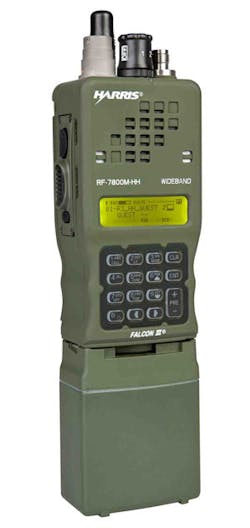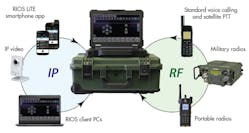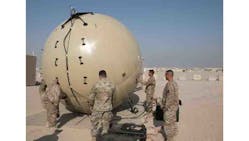Download this article as a .PDF
Electronic systems have long been something of a “front end” for most military activities. While battles are fought by people, electronic systems provide warnings of trouble and communications between troops. There are many different electronic systems used as part of military activities, including communications, electronic warfare (EW), and radar systems. In all cases, these systems must leverage the latest electronic technologies to provide the greatest benefits to the warfighter.
Military communications systems face many challenges to successful operation, including interception of signals and jammers that prevent radios from receiving signals. For years, terrestrial military radios have been following a trend of “borrowing” technology from commercial cellular telephones to make military radios smaller, lighter, and more secure.
As a result, military radios employ many of the digital modulation formats used in commercial wireless communications devices, along with the programmability of software-define-radio technology to switch frequency bands and communication formats when one band is being jammed or is unavailable due to interference or weather conditions.
In the interest of security, different branches of the military have formulated different waveforms for ground mobile radios (GMRs) including the Soldier Radio Waveform (SRW) and the wideband networking waveform (WNW). With terrorism rampant, communications security is critical not just on the battlefield but for homeland security, law enforcement, and government users. In addition to more advanced communications waveforms, modern military radio solutions must be capable of working with legacy waveforms still in use, such as the Link 16 waveform.
Tactical terrestrial military radios are meeting these challenges by means of hardware with extremely broadband frequency coverage, including satellite-communications (satcom) frequencies, and through the flexibility of software-defined-radio (SDR) technology, which can change the radio’s operating characteristics to match the requirements of a particular network. As an example, the RF-7800M-HH tactical radio (Fig. 1) from Harris Corp. is built to withstand the rigors of the battlefield, but it looks very much like an early-generation cell phone.
In spite of appearances, however, it is quite advanced, with a Software Communications Architecture (SCA) based on software programmability to adapt to changing environments. It provides simultaneous voice and high-speed-data communications using narrowband and wideband radio waveforms. The software-upgradeable radio uses both ANW2C and M-TNW waveforms and has the capability to network with a variety of other types of radios, including military satcom radios. It is capable of frequency hopping for security and available with optional satcom TDMA capability.
With the many different design approaches used in terrestrial and airborne tactical radios—and a desire by military users to have access to commercial radios and even Internet of Things (IoT) sensors for surveillance data—military communications interoperability is one of the prime concerns for modern military communications technology. Military ad hoc networks consist of radios and users not just on the ground and in ground vehicles, but in aircraft-mounted radios as well (and in some cases, in UAV-mounted radios). All must be capable of communicating in a secure manner.
Interoperability depends on fixed and mobile ad hoc network (MANET) nodes, such as the RIOS TAC2 Tactical Radio Interoperability Gateway from Systech Corp. It allows many different users, such as public safety, federal agencies, and military users, to interconnect with many different radios and frequency bands, including HF, VHF, UHF, and 700/800-MHz bands (Fig. 2). It includes interfaces for RIOS Client Computers, RIOS LiTE for Android and iPhone commercial cell phones, and options for satellite phones and Voice-over-Internet-Protocol (VoIP) devices.
The mobile gateway is compatible with a variety of tactical radios, including those from Motorola, Harris, and Kenwood. It has an on-board router with full wireless capabilities for cellular, Wi-Fi, and WLAN connectivity to support communications among many different devices (Fig. 2). Signals from one radio format can be converted to another radio format and retransmitted to a desired network not matter the format or frequency, allowing communications between initially incompatible devices.
The mobile gateway has on-board power management for continuous power from AC or DC source or its integrated lithium-ion rechargeable battery pack. The 40-lb. gateway is designed to run for 6 to 8 hours on its built-in battery pack. It is an example of the type of gateway equipment needed for rapid formation of wireless mesh networks and MANETs to enable communications interoperability, especially with the growing number of networked wireless IoT devices used for data gathering and signal detection, as well as autonomous UAVs under network control.
Cognitive radio technology is also helping to meet military challenges of communications interoperability. This technology, which essentially uses computer intelligence to automatically select the radio characteristics needed for successful communications, not only adapts to different network requirements, but can instantly switch to unoccupied frequency bands in the event of interference and/or jamming.
Technology advances for military communications are affecting more than just radios—even components considered mature sometimes get a new look. The U.S. Army recently unveiled an inflatable ground-terminal antenna for satcom systems (Fig. 3). The ground antenna transmit and receive (GATR) ball is the Army’s latest satcom component. It is much lighter and more portable than traditional satellite dish antennas. The GATR ball is designed to be carried anywhere in the world in a few cases, and can be inflated and assembled in less than two hours to perform a variety of communications services.
Sergeant First Class Brian Horne, information assurance supervisor for the 369th Signal Battalion (SB) that has developed the portable antenna, explained that “it can be set up and operated by a crew of three just about anywhere.” But the antenna doesn’t sacrifice performance for portability. It provides larger bandwidth capacity than the legacy antenna system it replaces, allowing operators to send more data.
Sargent Moises Orta, a multichannel transmission systems operator/maintainer for the 369th SB, concurred with this assessment: “The GATR Ball is capable of more data transfer in a smaller package compared to the traditional satellite systems.”
Airborne nodes are of growing importance for military communications networks, and the technology for such communications has been in development for several years. Boeing and the U.S. Air Force recently demonstrated networking between multiple ground stations and several aircraft, using Boeing’s Talon HATE airborne networking system. Flight tests were conducted at Nellis Air Force Base, N.V. with two Talon HATE pods on two F-15C aircraft.
Communications were performed with the military’s Link 16 waveform, Common Data Link (CDL) protocol, and Wideband Global Satcom (WGS) satellites. Additional flight testing also validated intraflight data-link communications between F-22 aircraft. Such never-before-possible intra-aircraft networking will provide fighter pilots with invaluable additional data, including intelligence gathered from pilots in other aircraft.
Of course, communications is just one technology area within defense electronics, with innovation and development taking place in many other key areas, including in EW and radar systems. EW systems are following a technology path that parallels that of tactical radios, relying on embedded system computers for analysis and decision making regarding acquired signal information when reacting to different threats.
Known as cognitive EW, the technology has been in development for several years, motivated by DARPA’s Adaptive Radar Countermeasures (ARC) program and the fear that traditional EW systems would not be agile enough to respond to the rapidly changing waveforms generated by enemy adaptive radar systems. Major contractors involved in development of cognitive EW systems include BAE Systems, Boeing, Lockheed Martin, and Raytheon Co.
DARPA is pursuing an open-architecture approach with the ARC program to enable U.S. airborne EW systems to automatically generate electronic countermeasures (ECM) responses against new, unknown, and adaptive radars in real time. Having an open architecture will allow for development of EW systems in a modular hardware and software configuration so that updating a system by changing modules will have minimal impact on other elements of the EW system. The modules developed for the ARC program will be suitable for new systems and for retrofitting existing EW systems.
The ARC modules should be capable of isolating unknown radar signals in the presence of other signals, both friendly and hostile, and perform analysis on the signals to determine the nature of the potential threat. An ARC solution must be capable of synthesizing and transmitting ECM signals to the threat radar for a desired response, and assess the effectiveness of the countermeasures based on the over-the-air observable behavior of the threat transmitter.
About three years ago, the U.S. Navy established a need for what is described as electromagnetic maneuver warfare (EMW), to measure environmental variables at multiple heights from a fixed location, such as the deck or mast of a ship. The data would be part of predicting the EM and electro-optical (EO) propagation from surface ships to support data from and the performance of radar, EW, laser, and communications systems.
The EMW efforts were begun because of a dissatisfaction with existing in situ sensors, which were deemed expensive and unreliable, and the quest was to replace such sensors with a more accurate and practical solution. Any system solution should also be maintainable in a naval environment. Technologies being considered include acoustic sounders, Doppler LIDAR and LIDAR spectroscopy, and passive radiometry.
This is a brief survey of recent trends in defense electronics, with similar pursuits of technology improvements in all areas. While some of these programs are aimed at combatting the growing use of enemy UAVs to perform surveillance and carry weapons, contractors such as Raytheon are also working with the Air Force Research Laboratory (AFRL) Directed Energy Directorate at Kirtland Air Force Base, N.M. on the integration of high-power electromagnetic (HPEM) weapons into suites of aircraft weapons. Such weapons are meant to disable enemy electronic systems without harming soldiers.
Continuing efforts at technology improvements, such as the practice of “persistent surveillance,”—the use of software-defined sensors to gather intelligence, even as environmental conditions are changing—are helping to maintain a tactical edge for U.S. troops and their allies. Strong funding from the current administration should help to continue to support this trend of technological advances and improvements.




